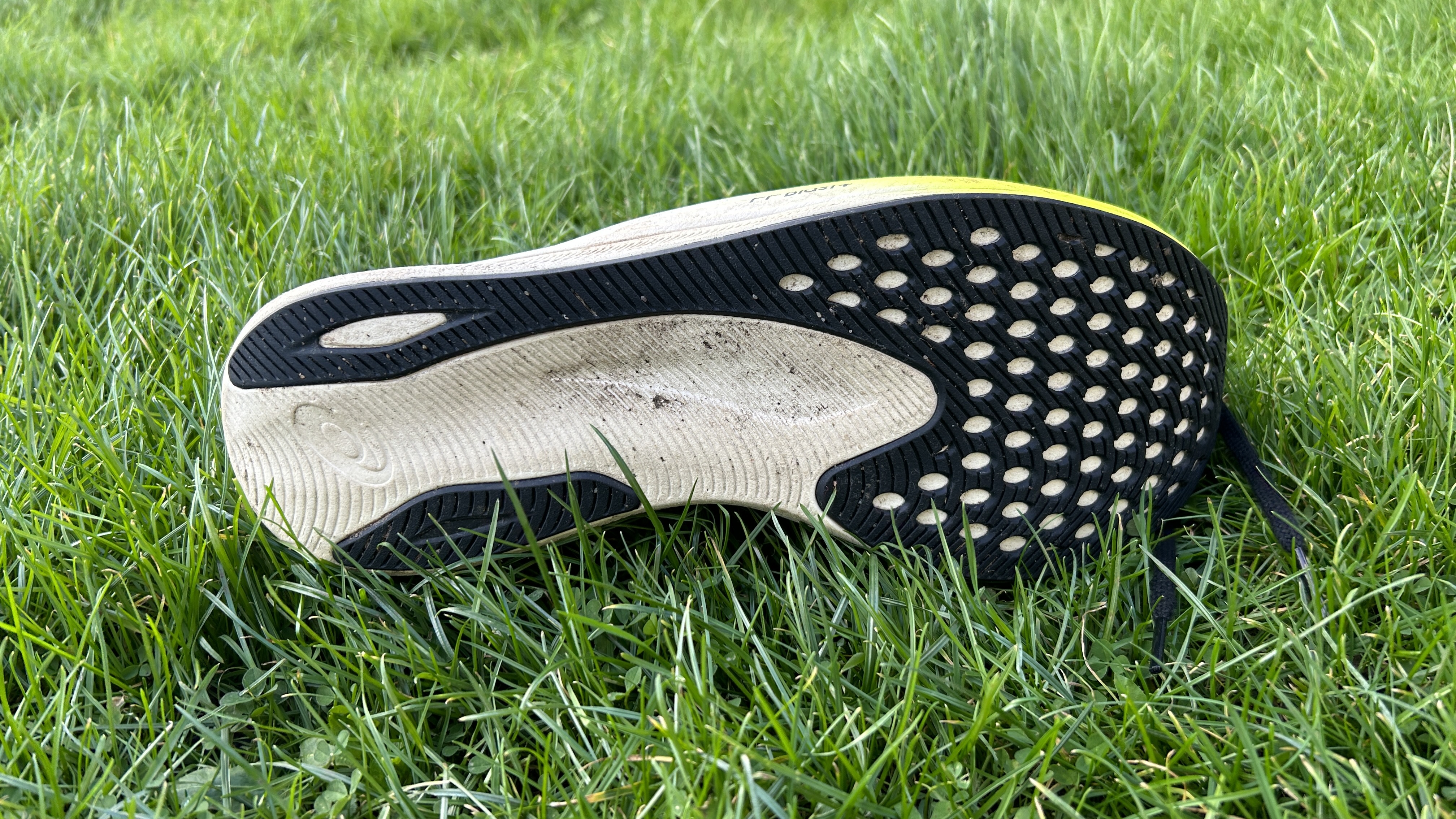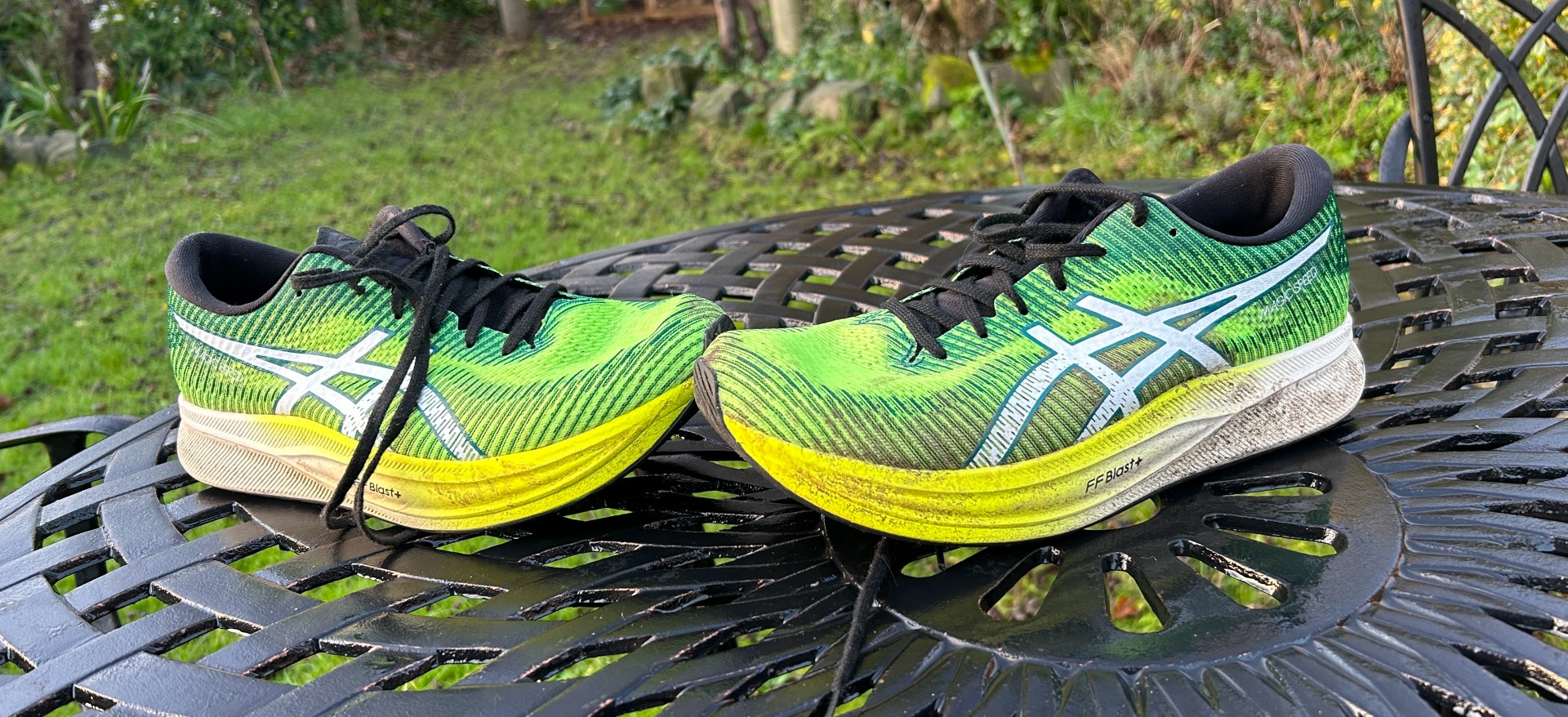Our Verdict
The Asics Magic Speed 2 is lightweight, fast and a lot of fun to run in. While it doesn’t match the performance of super-shoes including the Asics Metaspeed Sky+, it’s a great versatile training shoe that is still speedy enough for races.
For
- Versatile training and racing option
- Carbon/TPU plate
- Cheaper than full super-shoes
Against
- Still quite expensive
- Not as fast as others
You can trust Coach
The Magic Speed 2 is the plated training shoe in Asics’s range, designed to be used in partnership with one of the brand’s carbon plate running shoes – the Asics Metaspeed Sky+ and Metaspeed Edge+.
However, the Magic Speed 2 stands on its own as a good racing option if you don’t want to splash out on a full super-shoe, while still being comfortable enough to use for daily training as well. It’s one of the best running shoes, and a stern competitor to the Saucony Endorphin Speed 3, which we rate as the best all-rounder shoe available.
Asics Magic Speed 2 Review: Price And Availability
The Magic Speed 2 was launched in September 2022 and costs $150 in the US and £170 in the UK, which is considerably cheaper than Asics’s top super-shoes the Sky+ and Edge+, which are $250/£225.
Design And Fit
Asics has made a few notable updates to the Magic Speed shoe with version 2. First, the plate in the midsole (which is a mix of carbon and TPU) now runs the whole length of the shoe, whereas the original Magic Speed only had a half-plate under the forefoot.
The drop of the shoe has also increased to 7mm from 5mm on the first Magic Speed, and the top layer of foam in the midsole is now FF Blast+, a bouncier foam than the FF Blast used on the Magic Speed. The stack height is 37mm at the heel and 30mm at the forefoot including insole and outsole (it’s listed as 34mm/27mm by Asics without including those layers).

Underneath the layer of FF Blast+ on the Magic Speed 2 is a layer of Flytefoam, which is less springy but firmer and more durable. This is important because there is a lot of exposed foam on the outsole of the shoe, and this is all Flytefoam, which means it doesn’t get torn up as easily as the softer exposed foam on the Asics Metaspeed Sky+ and Edge+ shoes.
There is rubber coverage on the forefoot of the outsole, and the two strips at the back of the Magic Speed 2 provide just enough traction without adding too much weight. The shoe weighs 8.4oz/238g in my UK size 9.
Sign up for workout ideas, training advice, reviews of the latest gear and more.
The upper on the shoe is made from a lightweight engineered mesh, with a little padding around the heel collar. The shoe fit me well in my normal size, though people with wider feet might find it runs a little narrow in the midfoot.
How I Tested This Shoe
I have run 50km in the Asics Magic Speed 2, using it for several speed sessions plus a couple of easy runs. I did not test the original Magic Speed, but I have tested the Metaspeed Sky+ and Edge+.
Running Performance
The Asics Magic Speed 2 impressed me on every run. It has a speedy but comfortable ride that makes it suitable for a variety of training runs, and while it doesn’t have the all-out propulsive pace of a full carbon super-shoe, it’s still fast enough for racing if you want a cheaper option.
I did a couple of interval sessions in the shoe, one that included a hard 5K and then shorter reps and one where I used it for the second half of a 10 x 3min session, after using the New Balance Rebel v3 for the first half. The Magic Speed 2 works well for short and long reps alike, being light and nippy enough for sprints and then comfortable and efficient when cruising through longer reps.
The comparison with the Rebel v3, which is a light and fast shoe but doesn’t have a plate, showed the efficiency benefits of the Magic Speed 2’s design. The Rebel is bouncy and great fun, and I ran a similar pace in both shoes, but the plate and more rockered design of the Magic Speed 2 helped me tick through 3min reps well even as I tired towards the end of the session.

I also ran a steady hour in the Magic Speed 2, covering around 16.5km, and this was the run I enjoyed most in the shoe. Like other top-tier plated training shoes such as the Saucony Endorphin Speed 3 and Puma Deviate Nitro 2, the Magic Speed 2 helps you maintain a controlled effort and when running on feel or heart rate your pace can be faster than you might expect.
The Magic Speed 2 was also comfortable to use on short easy runs, though it wouldn’t be the ideal choice for plodding through long relaxed runs since it is geared for speed and isn’t as comfortable as the best cushioned shoes. However, it would be a good option for faster long runs, and racing half marathons and marathons.
Is The Asics Magic Speed 2 Worth It?
I wasn’t expecting to enjoy wearing the Magic Speed 2 as much as I did. It’s certainly one of the best running shoes out there, with a versatile and enjoyable ride, and one to consider for those seeking a fast trainer for their rotation in particular.
The problem is the competition is so fierce in its category – the Saucony Endorphin Speed 3 and Puma Deviate Nitro 2 are also excellent shoes. There’s also the fact that full carbon super-shoes like the Nike Vaporfly 2 and Saucony Endorphin Pro 3 now regularly drop well below $200/£200 in sales, which means the Magic Speed 2 loses some appeal as a cheaper racing option.
As a fast daily trainer the Saucony Endorphin Speed 3 probably still has the edge for me. It has a bouncier midsole foam and a wider, more stable design that makes it better for long runs. The Magic Speed 2 is just as fast, maybe even slightly faster, but the Speed 3 is more versatile.
The Puma Deviate Nitro 2 is heavier and less speed-focused, but a better daily trainer than the Asics because of its thicker outsole, which offers more grip and durability. It’s also still fast enough for speed sessions, though I would certainly prefer to be in the Magic Speed 2 or Endorphin Speed 3 when racing.

Nick Harris-Fry is a journalist who has been covering health and fitness since 2015. Nick is an avid runner, covering 70-110km a week, which gives him ample opportunity to test a wide range of running shoes and running gear. He is also the chief tester for fitness trackers and running watches, treadmills and exercise bikes, and workout headphones.


